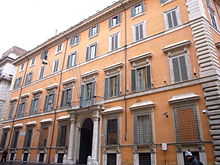Palazzo Giustiniani

The Palazzo Giustiniani is a city palace in Rome . It is located on Via della Dogana Vecchia in the Sant'Eustachio district . The President of the Italian Senate has his residence in the Palazzo Giustiniani . The offices of the Senators for Life , the former Presidents of the Senate and some administrative offices of the Senate are also located here. From 1901 to 1985 the Palazzo Giustiniani was also the seat of the Grand Lodge Grande Oriente d'Italia .
history
The palazzo was built for Monsignor Francesco Vento at the end of the 16th century , but was then acquired by Giuseppe Giustiniani in 1590, who came from a Genoese noble family that had lived in Chios for a long time . His son, Benedetto Cardinal Giustiniani, acquired a few neighboring buildings and thus a connected building complex very close to the Pantheon . The cardinal's brother, Vincenzo Giustiniani , enriched this family residence with an art collection that included around 1,600 statues and paintings, including works by Giorgione , Titian , Raphael and Caravaggio . Over time, the palazzo has been rebuilt or modified several times, in particular by the architect Francesco Borromini .
After the Giustiniani family died out, the noble Grazioli family acquired the Palazzo in 1859 and rented it in 1898 to the Grande Oriente d'Italia , who set up their headquarters there in April 1901. Benito Mussolini's fascist government, which early on against Freemasonry had provided, acquired the building in 1926 and left it to the neighboring Palazzo Madama meeting participants Senate . The following dispute between the grand lodge and the government was amicably settled by allowing part of the building to remain open to the Freemasons. In 1938 the Palazzo Giustiniani was connected to the Palazzo Madama by an underground passage that is still in use today. In 1985 the Grande Oriente moved to the Villa del Vascello on the Gianicolo ; since then the Palazzo Giustiniani has belonged entirely to the Italian Senate.
The Palazzo Giustiniani was the official residence of the provisional head of state Enrico De Nicola from 1946 to 1948 . After the abolition of the monarchy, he did not want to use the Quirinal Palace , also because of the temporary nature of his office . On December 27, 1947, in the library of the Palazzo Giustiniani, Enrico De Nicola signed the Constitution of the Italian Republic, adopted by the Constituent Assembly . This room has since been called Sala della Costituzione and is sometimes used for receptions for foreign state guests.
Others
If the President of the Senate, as Vice President of the Republic, temporarily takes over the (domestic) official business of the President because he is prevented or is abroad, parts of the President's Life Guard ( Corazzieri ) perform their duties at the official seat and at the residence of the President of the Senate.
Web links
Coordinates: 41 ° 53 ′ 57.1 ″ N , 12 ° 28 ′ 31.3 ″ E

